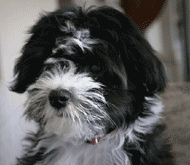Dogs are part of the family and should always be taken with you when you move – even it’s the 1500’s and the move is from "civilized" Europe to the wilds of the New World. But dogs braved the harsh sea voyages along with their families and settled down to start a New World with them. In Cuba, which Columbus claimed for Spain in 1492, a distinct spunky toy breed developed known today as the Havanese, named after Cuba’s capital city Havana.
The toy dogs from Europe eventually grew into their own characteristic selves in Cuba. Their fur got long and silky, giving them a name Havana Silk Dog, which they are still sometimes called. The coat got wavy or curly with two layers. Some shorthaired were born and sometimes still are, but they are not considered show worthy dogs. The eye rims, nose and lips are always black. They were considered a luxury item and the dogs of the upper class. When the Cuban Revolution hit, the upper class had to flee Cuba to America and Europe, and brought along their dogs.
The Havanese settled in well to wherever they are bound, and America has been no exception. They only arrived in America in the 1970’s so there are not as many as for more well established breeds. They are recognized the American Rare Breeds Association and the American Kennel Club. The Havanese makes great apartment and family dogs with a perky and optimistic attitude. They can be quite playful and need a good romp at least once a day. They continue to be the companion dogs of choice for those families lucky enough to live with them.
The National Dog of Cuba, the Havanese, which took centuries to develop, was nearly wiped out in the Cuban Revolution. Part of the story behind the Havanese is that they love to be with people, wherever they travel, in and out of the show ring.
Tuesday, March 4, 2008
Subscribe to:
Posts (Atom)
